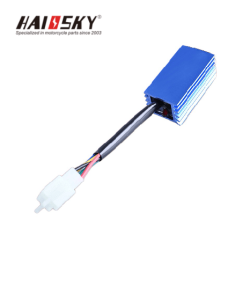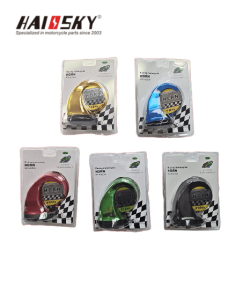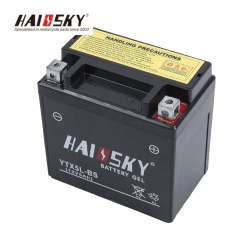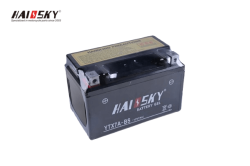OEM Motorcycle Parts
Category: Motorcycle Electrical Systems - Wiring & Charging
Everything You Need to Know About Motorcycle Electrical Parts
Motorcycle electrical parts are the backbone of a bike’s functionality, powering everything from the ignition system to the lights and sensors. Whether you’re a B2B wholesaler or a rider, understanding these components is crucial for ensuring optimal performance, safety, and reliability. At Haissky.com, we specialize in providing high-quality motorcycle electrical parts to meet the needs of every rider. In this guide, we’ll explore the types of electrical parts, their functions, maintenance tips, and how to choose the right components for your motorcycle. We’ll also answer some frequently asked questions to help you make informed decisions.
What Are Motorcycle Electrical Parts?
Motorcycle electrical parts are components that manage and distribute electrical power throughout the bike. They include the battery, alternator, wiring harness, sensors, switches, and control units. These parts work together to power the ignition system, lights, indicators, and other electronic features, ensuring the motorcycle operates smoothly and safely.
Types of Motorcycle Electrical Parts
Motorcycle electrical systems are complex, with various components playing specific roles. Here are the most common types of electrical parts:
1. Battery
The battery is the heart of the electrical system, providing the initial power needed to start the engine and run electrical components when the engine is off.
Pros: Essential for starting the bike and powering accessories.
Cons: Requires regular maintenance and eventual replacement.
2. Alternator/Stator
The alternator (or stator) generates electricity while the engine is running, recharging the battery and powering the bike’s electrical systems.
Pros: Keeps the battery charged and powers the bike’s electronics.
Cons: Can fail due to wear or overheating.
3. Wiring Harness
The wiring harness is a network of wires that connects all electrical components, ensuring proper communication and power distribution.
Pros: Organizes and protects wires for reliable performance.
Cons: Damaged wiring can cause electrical failures.
4. ECU (Engine Control Unit)
The ECU is the brain of the motorcycle, controlling engine functions like fuel injection, ignition timing, and emissions.
Pros: Optimizes engine performance and efficiency.
Cons: Expensive to replace if damaged.
5. Regulator Rectifier
The regulator rectifier converts AC power from the alternator into DC power to charge the battery and stabilizes voltage levels.
Pros: Protects the battery and electrical system from overcharging.
Cons: Can fail due to overheating or electrical surges.
6. Sensors
Sensors monitor various parameters, such as engine temperature, throttle position, and wheel speed, sending data to the ECU for optimal performance.
Pros: Enhances engine efficiency and safety.
Cons: Malfunctioning sensors can cause performance issues.
7. Switches and Relays
Switches and relays control the flow of electricity to components like lights, indicators, and the starter motor.
Pros: Essential for operating electrical systems.
Cons: Wear and tear can lead to failure.
8. Lights and Indicators
Lights (headlights, taillights, brake lights) and indicators are critical for visibility and safety.
Pros: Ensure safe riding in low-light conditions.
Cons: Bulbs and LEDs may need periodic replacement.
Specifications and Maintenance of Motorcycle Electrical Parts
Proper maintenance ensures the longevity and performance of your motorcycle’s electrical system. Here are some key tips:
1. Battery Maintenance
Regularly check the battery’s charge level and terminals for corrosion.
Keep the battery charged, especially during long periods of inactivity.
2. Wiring Inspection
Inspect the wiring harness for frayed wires, loose connections, or damage.
Use electrical tape or heat shrink tubing to repair minor damage.
3. Sensor Care
Clean sensors regularly to ensure accurate readings.
Replace malfunctioning sensors promptly.
4. Light Checks
Test all lights and indicators regularly to ensure they are functioning.
Replace burnt-out bulbs or faulty LEDs immediately.
5. ECU and Regulator Rectifier
Keep these components clean and free from moisture.
Replace them if you notice signs of failure, such as erratic engine behavior or battery overcharging.
How to Choose the Right Motorcycle Electrical Parts
Selecting the right electrical parts depends on your motorcycle’s make, model, and specific needs. Here are some factors to consider:
1. Compatibility
Ensure the parts are compatible with your motorcycle’s electrical system and specifications.
2. Quality
Opt for high-quality parts from reputable brands to ensure reliability and durability.
3. Performance
Choose parts that enhance your bike’s performance, such as high-output alternators or advanced ECUs.
4. Ease of Installation
Select parts that are easy to install or come with clear instructions.
5. Budget
Set a budget and choose parts that offer the best value for money without compromising on quality.
How to Diagnose and Replace Motorcycle Electrical Parts
Diagnosing and replacing electrical parts can be challenging but manageable with the right tools and knowledge. Here’s a step-by-step guide:
Tools Needed:
Multimeter
Screwdrivers
Wire cutters and strippers
Electrical tape
Replacement parts
Steps:
Identify the Problem: Use a multimeter to test the electrical system and identify faulty components.
Disconnect the Battery: Always disconnect the battery before working on the electrical system.
Remove the Faulty Part: Disconnect wires and remove the faulty component.
Install the New Part: Connect the new part and secure it in place.
Test the System: Reconnect the battery and test the new part to ensure it functions correctly.
Frequently Asked Questions
Q1: What are the electrical parts of a motorcycle?
The electrical parts include the battery, alternator, wiring harness, ECU, regulator rectifier, sensors, switches, and lights.
Q2: How to diagnose electrical problems on a motorcycle?
Use a multimeter to test voltage, continuity, and resistance. Check for loose connections, damaged wires, or faulty components.
Q3: What do I need to rewire a motorcycle?
You’ll need a wiring diagram, wire cutters, strippers, electrical tape, and a new wiring harness.
Q4: What do the colors of motorcycle wires mean?
Wire colors indicate their function (e.g., red for power, black for ground). Refer to the wiring diagram for specifics.
Q5: What is an ECU on a motorcycle?
The ECU (Engine Control Unit) is the bike’s computer, managing engine functions like fuel injection and ignition timing.
Q6: What does a regulator rectifier do on a motorcycle?
The regulator rectifier converts AC power from the alternator to DC power, charging the battery and stabilizing voltage.
Conclusion
Motorcycle electrical parts are essential for ensuring your bike’s performance, safety, and reliability. Whether you’re a B2B wholesaler or a rider, understanding these components and their maintenance is crucial for optimal functionality.
At Haissky.com, we offer a wide range of high-quality motorcycle electrical parts designed to meet the needs of every rider. Explore our collection today and find the perfect components for your inventory or personal use!















